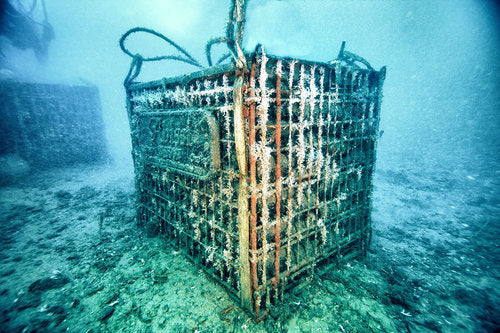The wine world loves its tradition, but it's also home to some wacky trends. Trends such as: wines on tap, screw top wines, and now the latest phenomenon, aging wine underwater.
Yo ho, Merlot, A Pirates Life for Me. How did this new and latest trend come about? Pirates! Ok not really. But in actual fact sunken ships had a lot to do with it. After several bottles of wine were discovered on ship wreckages, wine makers discovered the ocean may have aided in the aging process.
Related: How a wine barrel impacts the flavor of your wine
Why Age Wine Underwater?
The 1998 discovery of champagne bottles in a Swedish schooner wrecked in 1916 by some divers in the Baltic Sea didn't seem like a big deal at the time. One of the bottles was opened by the divers when they reached land. It was amazing how drinkable and tasty the champagne was. This was the birth of underwater wine, despite it taking a few years to catch on.
How it works?
Initially, underwater wine was just a curiosity, but what wineries discovered turned the practice into a worthwhile business opportunity.
In Spain, ElixSea found that wine stored underwater ages faster than wine stored on land, while maintaining the same quality. This allows the wine to age much faster, resulting in a faster production process.
The sea floor has no light and very little noise. It's temperature is cool and constant. In many ways It's an environment wine is used to yet it holds some unique possibilities. Some say the swaying of the ocean keeps the wine in a constant state of motion, which can bring out secondary and tertiary aromas that may not have come through before. Is this theory true? It has been reported that wineries in Italy, France and Spain are aging wine underwater. There are many benefits to aging wine underwater.
While scuba-loving winemakers will likely find a variety of benefits to aging wine underwater, there are also plenty of disadvantages to consider. There are saltwater contamination risks and wine-loving mollusks to beware of. As well as the cost of dumping each bottle into the ocean, the cost of retrieving them is also involved.
Have you upgraded your wine tasting experience recently? We offer decanter glasses, charcuterie boards, and stemware for your future wine nights.
Is it Just a Passing Trend?
Sunken Treasure or Fools Gold? Like any trend, there are sure to be skeptics and believers. The naysayers feel this passing trend is just a marketing ploy, a veiled attempt to offer consumers the latest and greatest idea. However, serious wineries are giving this concept, now being referred to as "Aquoir", a try. Mira Winery in Napa, Sketch Winery in Spain, and Gaia Winery in Greece are just some winemakers who have decided to experiment with this concept. Chateau Larrivet Haut-Brion in France recently submerged a barrel of Bordeaux they've aptly named Neptune. And even the team at Veuve Clicquot has climbed on board (pun most definitely intended). They built their own undersea storage container where they will monitor the progress of a selection of their bottles for the next fifty years. You better believe we'll be counting down the years!
Related: How Long to Let Wine Breathe: Red to White Explained
Whether it be to optimize storage space, prolong the aging process, or simply experiment for experiments sake, more and more wineries are walking this plank. We at Taste of Purple can't wait to see what washes ashore!
What The Wine Tastes Like

Related: How Long Does Wine Last? Before & After Opening
First of all, it tastes great! In general, underwater wines tend to have a long lingering taste than land-aged wines, although the flavor differs from harvest to harvest and bottle to bottle.
The aftertaste is slight, with an iron-like taste, but it is pleasant and natural. It's important to keep in mind that the saltwater surrounding bottles (or tanks) never interacts with the wine. It is natural for the wine to have a taste of saltiness or minerality. This salty flavor enhances the tannins, contributing to the wine's distinctive long finish.
Winemaker Josef Moth, who sank wine in tanks deep in Lake Constance, found that the wines that emerged were more aromatic than those he aged on land. He took his wine down 196 feet, which is much deeper than usual 65 feet. According to him, the taste difference is quite noticeable. A significant change in taste was confirmed by scientists as well as Professor Robert Steidl, head of the Federal Office for Viticulture.
Are you looking for some stunning new glassware to show off your style at your next wine and cheese party? Discover the perfect stemware and wine glasses for your home today with Taste of Purple's featured collections.
